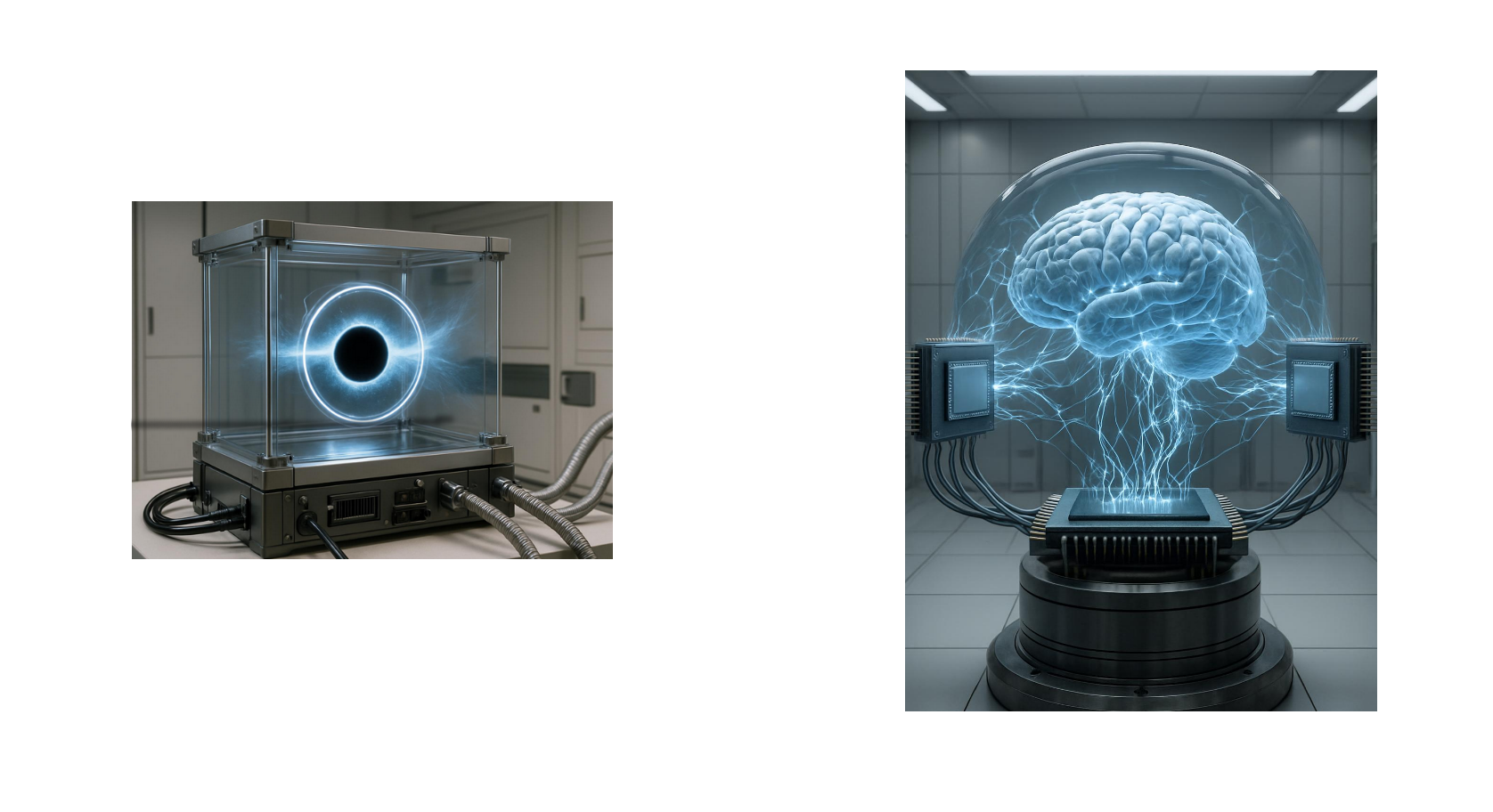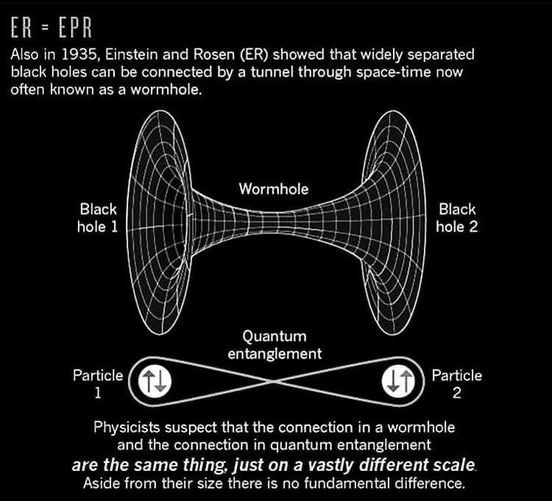www.QuantumBrainComputerInterface.com
Informational Website with Speculative Ideas
quantumbraininterface@gmail.com

auto-generated images
There could be a "Communication Theorem" instead of a "No-Communication Theorem" in quantum entanglement if we could measure and manipulate negative energy.
According to the ER=EPR conjecture by Susskind and Maldacena, traversable wormholes—which are postulated to require negative energy (or a vacuum force)—might be equivalent to a "Communication Theorem" in Quantum Gravity.
Furthermore, the application of negative energy in quantum entanglement could bypass the conventional requirement for Bell state measurement and classical communication, which are necessary in standard Quantum Teleportation protocols due to the limitations of not operating within pure superposition.
Quantum Entanglement and the Brain
What if the infrared photons generated by mitochondria become entangled—either with each other or with neuronal structures such as microtubules? Could this create a cascading effect, where the entangled pairs feed back into neurons, allowing the classical communication of four possible quantum states to be transmitted through electro-neurochemical signaling?
Could it be negative energy that opens or connects quantum wormholes that allow the classical transmission of bell statemeasurements?
Is it negative energy that "by passes" the non-traversability of wormoles and the non communication theorem that allows direct communication with neurons?
Could gravity be measured/observed and guided allowing quantum entanglement and the bell state measurements to transceived to allow the quantum operation?
Can you use negative time to attain coherence by sending to the past the quantum fluctuation measurements?
Google's Attempt:
(PDF) Testing the Conjecture That Quantum Processes Create Conscious Experience (LINK)
Google's Top AI Scientist on Consciousness via Quantum Superposition | Hartmut Neven (YOUTUBE)
This link presents two perspectives on how the brain might interact with quantum entanglement:
More Science News on Quantum Entanglement and the Human Brain
Proteins Double as Qubits: A Step That Could One Day Bridge Quantum Computing and Biology
Researchers recently tested a long-standing theory—and the results surprised them. Scientists at Washington State University developed a fluid that behaves as though it has negative mass. In practical terms, this means that when pushed in one direction, the fluid moves in the opposite direction—essentially flipping the normal rules of motion.
To create this effect, rubidium atoms were cooled to near absolute zero, forming a Bose-Einstein condensate—a unique state of matter where particles move in sync and behave as a single wave. The team used lasers to trap the atoms and adjusted their spin using another set of beams, forcing the condensate into a condition that mimicked the behavior of negative mass.
Additionally, experiments have provided evidence of 'negative time'—in which photons appear to exit a material before they enter it, suggesting a possible observational effect where time behaves unconventionally.
Source:
Proteins Double as Qubits – The Quantum Insider
"Microtubules as Fractal Time Crystals: implications for life and consciousness" by Stuart Hameroff
https://www.youtube.com/watch?v=YusrOYGAhqM
Field Guide Questions:
How is the Bell state measurement continually sent or updated to the receiving entangled particle?
Is there a mechanism—known or theoretical—by which entanglement updates can occur across distances?
What if someone quantum-entangled a black hole? Could the Bell state measurement be transferred or completed via gravity—or possibly through a form of time or space-time synchronization?
What if it's the vacuum force or negative energy that closes the space-time gap and allows us to send instantly bell state measurements at great distances?
Classical theories of gravity produce entanglement
Classical theories of gravity produce entanglement | Nature
Joseph Aziz &
Richard Howl
Nature volume 646, pages813–817 (2025)Cite this article
Abstract
The unification of gravity and quantum mechanics remains one of the most profound open questions in science. With recent advances in quantum technology, an experimental idea first proposed by Richard Feynman1 is now regarded as a promising route to testing this unification for the first time. The experiment involves placing a massive object in a quantum superposition of two locations and letting it gravitationally interact with another mass. If the two objects subsequently become entangled, this is considered unambiguous evidence that gravity obeys the laws of quantum mechanics. This conclusion derives from theorems that treat a classical gravitational interaction as a local interaction capable of transmitting only classical, not quantum, information2,3,4,5,6,7,8. Here we extend the description of matter used in these theorems to the full framework of quantum field theory, finding that theories with classical gravity can then transmit quantum information and, thus, generate entanglement through physical, local processes. The effect scales differently to that predicted by theories of quantum gravity, and so it gives information on the parameters and form of the experiment required to robustly provide evidence for the quantum nature of gravity.
(Alternate article: Could gravity produce quantum entanglement if it’s not fully quantum? | New Scientist )
Media/News Speculation
It appears that NASA's Eagleworks team is investigating the Casimir Effect, potentially shedding light on negative energy and how quantum wormholes might enable Bell-state measurements via “spooky action at a distance.”
“Spooky action” is a term often associated with quantum nonlocality—and, interestingly, also linked to researcher James Matthew Tilly.
NASA Document:
NASA Technical Paper – Eagleworks
Additional Articles:
Warp Bubble Found? Scientists Explain How This Works
Science Times
→ Likely: Negative Energy / Warp Drive Physics
NASA Eagleworks: Space Warping and Quantum Vacuum Plasma Thruster – Propellantless Propulsion
NextBigFuture
→ Likely: Warp Drive Physics / Speculative Propulsion
Final Speculation: How Could This All Work?
Could gravity itself be a medium of quantum entanglement?
Might negative energy emerge in equations where time is treated as a negative variable?
Do rubidium atom condensates, and their odd properties (e.g., negative mass), relate to time-reversal or entanglement in any meaningful way? Could cooled rubidium atoms mediate negative energy as negative energy relates to negative time and/or negative mass through generally accepted equations?
Could one use negative mass to guide negative gravity as a beam or use negative energy based field beams to quantum entangle? Would either of negative gravity or negative energy allow bell state measurement transfers while simultaneously performing quantum entanglement? Does negative energy open quantum wormholes to allow classical information, such as bell state measurements be received at large distances?
There could be a "Communication Theorem" instead of a "No-Communication Theorem" in quantum entanglement if we could measure and manipulate negative energy.
According to the ER=EPR conjecture by Susskind and Maldacena, traversable wormholes—which are postulated to require negative energy (or a vacuum force)—might be equivalent to a "Communication Theorem" in Quantum Gravity.
Furthermore, the application of negative energy in quantum entanglement could bypass the conventional requirement for Bell state measurement and classical communication, which are necessary in standard Quantum Teleportation protocols due to the limitations of not operating within pure superposition.
Could gravity produce quantum entanglement if it’s not fully quantum?
Upcoming experimental tests of gravity’s quantumness aim to resolve one of the biggest questions in physics, but theorists are finding that the issue may be even more complex than they thought
https://www.newscientist.com/article/2500745-could-gravity-produce-quantum-entanglement-if-its-not-fully-quantum/
Physicists create 'negative mass'
by Eric Sorensen, Washington State University
Washington State University physicists have created a fluid with negative mass, which is exactly what it sounds like. Push it, and unlike every physical object in the world we know, it doesn't accelerate in the direction it was pushed. It accelerates backwards.
The phenomenon is rarely created in laboratory conditions and can be used to explore some of the more challenging concepts of the cosmos, said Michael Forbes, a WSU assistant professor of physics and astronomy and an affiliate assistant professor at the University of Washington. The research appears today in the journal Physical Review Letters, where it is featured as an "Editor's Suggestion."
September 30, 2024
5 min read
Evidence of ‘Negative Time’ Found in Quantum Physics Experiment
Physicists showed that photons can seem to exit a material before entering it, revealing observational evidence of negative time
